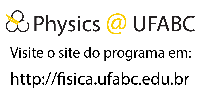Banca de QUALIFICAÇÃO: IARA NAOMI NOBRE OTA
Uma banca de QUALIFICAÇÃO de DOUTORADO foi cadastrada pelo programa.DISCENTE : IARA NAOMI NOBRE OTA
DATA : 22/04/2020
HORA: 16:00
LOCAL: via remoto
TÍTULO:
Testing the no-hair theorem with gravitational wave detections
PÁGINAS: 50
GRANDE ÁREA: Ciências Exatas e da Terra
ÁREA: Física
SUBÁREA: Física Geral
ESPECIALIDADE: Relatividade e Gravitação
RESUMO:
The detections of gravitational waves provide direct information about the nature of spacetime, the existence of black holes and allow us to test the theory of General Relativity. In particular, we can now test how closely an astrophysical black hole can be described by the Kerr geometry, i.e., test the no-hair theorem. The black hole remnant resulting from a binary black hole merger emits gravitational waves in the form of quasinormal modes, which can be described as exponentially damped sinusoids. The characteristic frequency and damping time of each quasinormal mode should depend only on the mass and spin of the black hole, and this frequency spectrum is parameterized by three indices: the harmonic numbers (l, m) and the overtone index n, that labels the fundamental mode (n = 0) and the overtones (n = 1, 2, 3, ...). Black hole spectroscopy proposes to use the quasinormal mode spectrum to test the no-hair theorem: the detection of the frequencies and decaying times of two modes will allow us to determine whether the modes are compatible with the same black hole. In this work, we analyze the perspectives for detection of the first overtone of the quadrupolar mode (l = m = 2). With the analysis of numerical relativity simulations, we show that the excitation amplitude of the first overtone, (l,m,n) = (2,2,1), will always be larger than the excitation amplitude of fundamental modes of the most dominant higher harmonics (2,1,0), (3,3,0) and (4,4,0), for non-spinning binaries with mass ratios of 1:1 to 5:1. For mass ratios of 6:1 to 10:1 the (2,2,1) mode has amplitude ratios comparable to (2,1,0) and (3,3,0). Regardless of the mass ratio, we showed that it will to be easier to distinguish in the detections the frequencies and decay times of the (2,2,0) mode from the (2,2,1) mode than form the (3,3,0) mode, which is the most dominant harmonic mode besides the (2,2,0) mode. Therefore, our work indicates a promising prospect for the detection of the (2,2,1) mode with future LIGO/Virgo detections.
MEMBROS DA BANCA:
Presidente - Interno ao Programa - 1549709 - GERMAN LUGONES
Membro Titular - Examinador(a) Interno ao Programa - 1768463 - OLEXANDR ZHYDENKO
Membro Titular - Examinador(a) Externo à Instituição - NADJA SIMÃO MAGALHÃES
Membro Suplente - Examinador(a) Interno ao Programa - 1574260 - ROLDAO DA ROCHA JUNIOR




